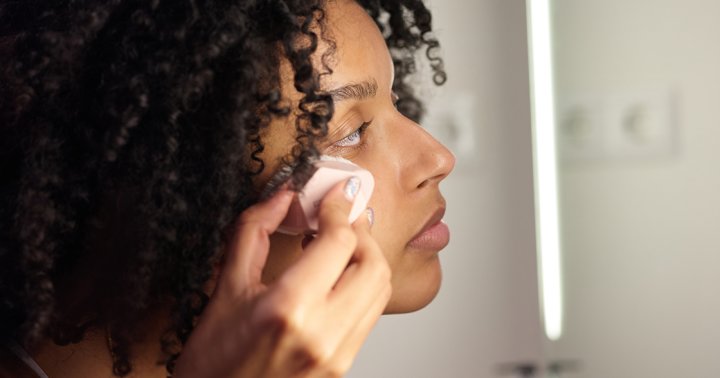So This Is The Reason Your Foundation Is Pilling — What To Do About It
Have you ever seen your foundation pill or flake right off the skin? This could be why.

Have you ever seen your foundation pill or flake right off the skin almost instantly upon application? Or maybe you've broken a sweat only to watch your makeup drip off your face in beads. While you may at first assume your foundation is faulty in itself, that's not always the case.
The science of makeup is a bit more complex than meets the eye. If you're wondering what's going on here and how to prevent it, we've got you covered.
Why your foundation might be pilling.
If your foundation isn't sitting right on the skin, it could be caused by incompatible products coming together. What makes products incompatible is their base ingredients. Some products are water-based, while others are silicone- or oil-based.
If your primer is made with a base ingredient that doesn't mix well with the base in your foundation, you'll likely experience pilling. This sounds sciencey, but let us break it down.
Cosmetic chemist Javon Ford recently summarized how to navigate this tricky situation via TikTok. "While you can layer oil and silicone on top of water, you can't do the reverse," Ford explains. Think of it like painting, he says, similar to how you can't add latex to an oil-based canvas.
You can also think about it in basic skin care layering protocol: This is why you first apply serums or essences (water-based) under creams or oils (silicone- or lipid-based). This is because water has the ability to sink into skin, while oil cannot. So oil (being a larger molecule) will sit on the surface, and not allow any water that you apply on top to penetrate.
But back to makeup. See, when you're using incompatible products in the wrong order, it will become a goopy mess. As Ford explains in the comments, "If you put a water-based foundation on top of silicone primer, it can bead or flake off."
So if your primer and foundation have different bases, just be sure to avoid putting a water-based foundation on top of a silicone-based primer. A water-based primer under a silicone foundation, however, is A-OK. And a silicone-based foundation with a silicone-based primer is also good to go; same goes for a water-based primer and water-based foundation.
Ford shared his go-to method for testing the compatibility of your products: When selecting a foundation, you'll want to use colored water to test the combination. Simply put a few drops of food coloring into a shot of water and mix. You can use undyed water, but the extra pigment makes it easier to spot the separation when you mix it with foundation.
Next, put a few drops of that colored water onto the inside of your wrist and mix it with the foundation in question. If the two products are not compatible, you'll be able to spot the beading and separation easily with your dyed water. If they are compatible, they should blend together without significant separation.
And if you're thinking, "Can't I just look at the ingredients?" we hear you. The truth is most foundations and primers alike list water as the first ingredient. This already turns the process into a guessing game.
What's more, not all silicones are listed ending in -cone, so it can be difficult to spot them in a lineup. So, unfortunately, the back of the bottle won't be as helpful as you may have thought.
This trick will take only a few seconds but will save you time, money, and frustration at the end of the day. Now you'll know which products to mix together, which ones to avoid, and achieve a smooth, lasting finish without testing and trashing countless foundations.
Nobody likes to see their foundation pill, flake, or bead off the skin. If you want to avoid that, make sure your primer and foundation have the same base—or at least layer them in the right order. As a rule of thumb, avoid putting water-based foundation on silicone-based primer. If your makeup still isn't sitting right on the skin, you may want to let your skin care set a bit longer before applying foundation—here's why.

 JimMin
JimMin 
































